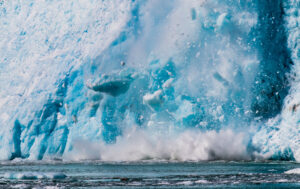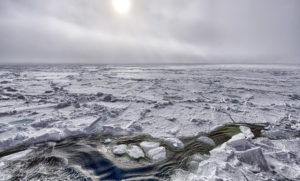Arctic Ice Depends on Half a Degree of Heat
That global temperature increment doesn’t sound like much, but it could make a world of difference to the polar ecosystem. Ice melts in a Greenland fjord. (Hannes Grobe / Wikimedia Commons)
Ice melts in a Greenland fjord. (Hannes Grobe / Wikimedia Commons)
Two separate studies have calculated what it would take to keep the Arctic ice frozen through the summer months – and thus preserve the precious polar ecosystem and help contain further global warming.
It’s simple: fulfil the promises that 195 nations made in Paris in 2015, and keep global warming to “well below 2°C” and ideally at 1.5°C by the year 2100.
That extra half a degree makes a huge difference. At a maximum global average warming of 2°C above the norm for most of human history, the Arctic could become technically ice-free once every three to five years.
Reduce carbon dioxide emissions even further, take greater steps to conserve forests and keep the global temperature at the 1.5° C maximum rise, and the chances are that the Arctic seaways will open only about one summer in 40 years.
Glaciologists consider the Arctic “ice-free” when there are only a million square kilometres of floe left. It has yet to happen. But the sea ice has become noticeably thinner, and smaller in surface area, over the last 40 years.
For more than two decades, meteorologists and oceanographers have repeatedly warned that runaway global warming, as a consequence of ever-greater combustion of fossil fuels, could bring about an ice-free polar ocean by about 2050.
Sea ice is part of the climate machine. It reflects solar radiation and keeps the ocean cool. It provides a surface on which Arctic seals can haul out, and on which polar bears can feed.
But the catch is that, although the world’s nations almost unanimously voted in Paris to contain global warming, the pledges made at the time were nowhere near ambitious enough.
Since the Paris meeting global warming has accelerated, and one group has warned that the 1.5°C limit could be exceeded by 2026. Many researchers think that the political decisions of the next decade will be vital.
Clear benefits
Researchers already know that the 1.5°C target will deliver palpable rewards: it will make a huge difference, for instance, to sea levels, grain harvests and global fish catches.
US and Canadian climate scientists set out to see what difference half a degree would make to the Arctic. They worked with different climate simulations to reach roughly the same conclusion, in two papers in the journal Nature Climate Change.
The Canadian team calculated that at 2°C, ice-free conditions would happen every five years; at 1.5°C, the hazard would drop to one in 40 years; at 3°C, permanent ice-free summers would be likely. A second study from the US backed up the premise.
“I didn’t expect to find that half a degree Celsius would make a big difference, but it really does,” said Alexandra Jahn, of the University of Colorado at Boulder.
Higher costs
“At 1.5°C half the time we stay within our current summer sea ice regime, whereas if we reach two degrees of warming, the summer sea ice will always be below what we have experienced in recent decades.”
Higher levels of warming would impose higher costs: 4°C of warming would deliver a high probability of an ocean free of ice for three months every summer by 2050, and five months a year by 2100.
“The good news is that the sea has a quick response time and could theoretically recover if we brought down global temperatures at any point in the future,” Dr Jahn said.
“In the meantime, though, other ecosystems could see permanent negative impacts from ice loss, and those can’t necessarily bounce back.”
Your support is crucial…With an uncertain future and a new administration casting doubt on press freedoms, the danger is clear: The truth is at risk.
Now is the time to give. Your tax-deductible support allows us to dig deeper, delivering fearless investigative reporting and analysis that exposes what’s really happening — without compromise.
Stand with our courageous journalists. Donate today to protect a free press, uphold democracy and unearth untold stories.









You need to be a supporter to comment.
There are currently no responses to this article.
Be the first to respond.